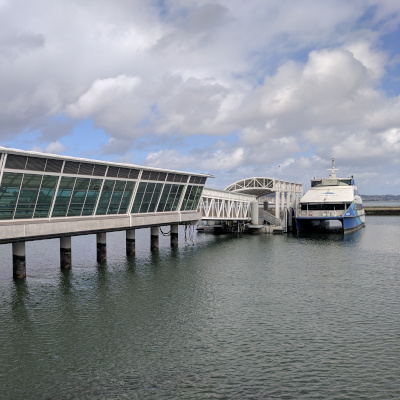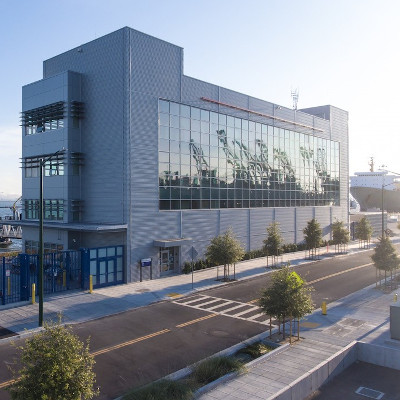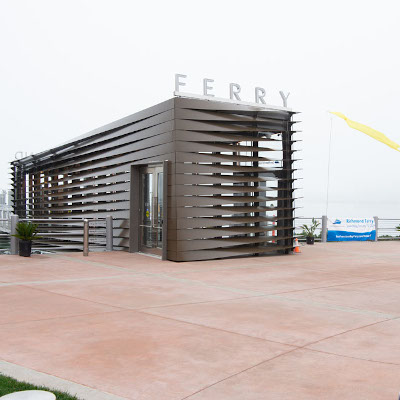WETA Timeline
In the early 1930s, a fleet of 50 ferries shuttled 50-60 million passengers across the Bay each year. With the construction of the Bay Bridge that same decade, ferry service saw a steep decline in interest and ridership, with just four public ferry boats serving the entire Bay Area in the late 1980s. That all changed in 1989 when the Loma Prieta earthquake struck, damaging the Bay Bridge and resulting in its closure for more than a month. During that time, traveling by ferry was the only way to cross the Bay.
The Loma Prieta earthquake is credited with renewing interest in water transit, and with gridlock on local freeways and bridges increasing in recent years, many Bay Area residents are looking for an alternative to crowded bridges, train cars and buses. For more than 20 years, the San Francisco Bay Area Water Emergency Transportation Authority (WETA) has been working to expand Bay Area public ferry service, while also preparing to respond to a major disaster that affects transbay transportation. Learn more about our history and what we’ve accomplished in the timeline below.

State Legislature Creates Water Transit Authority (WTA)
The state legislature created the San Francisco Bay Area Water Transit Authority (WTA) to plan new and expanded ferry service and related ground facilities in the Bay Area.

WTA Adopts Implementation and Operations Plan
WTA developed an Implementation and Operations Plan (IOP) and companion programmatic Environmental Impact Report, identifying seven new potential ferry routes.
Voters Approve RM2
Successful passage of Regional Measure 2 (RM2) in 2004 allocated local toll bridge funds for regional ferry system expansion.
SB 976 Establishes San Francisco Bay Area Water Emergency Transportation Authority (WETA) to Replace WTA
The governor signed SB 976, which created the San Francisco Bay Area Water Emergency Transportation Authority (WETA) as successor to WTA. It directed WETA to run a consolidated regional ferry system and prepare the system to respond to a natural or man-made disaster that disrupts bridge traffic in and out of San Francisco.
CalOES Approves $25 Million Proposition 1B Funds to Support WETA Expansion Projects
The California Governor’s Office of Emergency Services approved $25 million in state Proposition 1B bond funds to support the design and construction of planned WETA ferry terminals, facilities and vessels to be made available to support emergency response transportation services in the region.

WETA Expands its Ferry Fleet
The first two 225-passenger Gemini Class vessels, Gemini and Taurus, entered service.
WETA Delivers Transition Plan
WETA issued a Transition Plan as specified by recent legislation SB 1093, which laid out WETA’s plans for operating, financing and transferring city-run ferry services in Vallejo and Alameda to WETA.
Nina Rannells Appointed as Executive Director
Nina Rannells is appointed as WETA Executive Director, a position she would have until 2021.

WETA Expands Its Ferry Fleet
The final two 225-passenger Gemini Class vessels, Scorpio and Pisces, entered service.

WETA Enters into Operations and Maintenance Contract with Blue & Gold Fleet
Blue & Gold Fleet was selected to operate WETA’s consolidated San Francisco Bay Ferry System. Blue and Gold Fleet continues to operate San Francisco Bay Ferry today.

City of Alameda Services Transitioned to WETA
Consistent with state law, operation of the Alameda-Oakland and Harbor Bay services, previously managed by the City of Alameda, was transitioned to WETA.

South San Francisco Service Begins
Construction of the new South San Francisco terminal was completed, and service was launched.

San Francisco Bay Ferry is Born
The ferry service began operating under the new consumer-facing San Francisco Bay Ferry name.

City of Vallejo Services Transitioned to WETA
Vallejo ferry service, previously managed by the City of Vallejo, was transitioned to WETA. This transition included transfer of the system’s vessels and terminals, as well as responsibility to carry-out the planned construction of a new maintenance and operations facility on Mare Island.
Ferry Ridership Triples During BART Strike
San Francisco Bay Ferry’s ridership tripled as many Bay Area residents used the ferry system to commute to and from work. The BART strikes introduced many commuters to San Francisco Bay Ferry for the first time, creating a new group of loyal ferry commuters.
WETA Implements Enhanced Service Schedules to Meet Growing Demand
WETA initiated the first of what will be a series of service increases in response to skyrocketing demand resulting from the booming economy.
San Francisco Bay Ferry Ridership Increases 79% Over 5-Day Period During BART Closure
Over the five-day BART closure in the summer of 2015, San Francisco Bay Ferry carried 79 percent more passengers than normal compared to a similar five-day time period.
WETA Delivers Short-Range Transit Plan
WETA updated its 10-year Short-Range Transit Plan (SRTP), which provides an overview of WETA’s public transit ferry services and recent system performance, as well as a financially constrained 10-year projection of transit operating and capital expenses and revenues for the system.

WETA Approves Updated Emergency Response Plan
The WETA Board of Directors adopted an update to its Emergency Response Plan, which outlines WETA’s roles, responsibilities and procedures for coordinating the Bay Area water transportation response in the event of a catastrophic event, such as an earthquake.

WETA Opens Charlene Haught Johnson North Bay Operations and Maintenance Facility
WETA opens its first Operations and Maintenance Facility located on Mare Island.
WETA Completes Strategic Plan
The WETA Board of Directors approved the 2016 Strategic Plan, which sets forth a vision, mission and priorities for the next 20 years of San Francisco Bay Ferry service.

WETA Expands its San Francisco Bay Ferry Fleet
WETA’s first two 400-passenger Hydrus Class vessels, M.V. Hydrus and M.V. Cetus, entered service.

WETA Expands its San Francisco Bay Ferry Fleet
WETA’s third 400-passenger Hydrus Class vessel, Argo, entered service.

WETA Opens Ron Cowan Central Bay Operations and Maintenance Facility
WETA opened its second Operations and Maintenance Facility in Alameda.
Voters Approve RM3
Successful passage of Regional Measure 3 (RM3) allocated $300 million in bridge tolls to support ferry expansion on the Bay. However, the fate of funding from RM3 is still pending.

Richmond Service Begins
Construction of the new Richmond Ferry terminal at Ford Point was completed and service was launched.

WETA Expands its San Francisco Bay Ferry Fleet
WETA’s fourth and final 400-passenger Hydrus Class vessel, Carina, entered service.

WETA Expands its San Francisco Bay Ferry Fleet
WETA’s first two 445-passenger Pyxis Class vessels, Pyxis and Vela, entered service.
San Francisco Bay Ferry Serves 3 Million Passengers for the First Time Ever
In 2019, San Francisco Bay Ferry served a record-breaking three million passengers.

WETA Expands its San Francisco Bay Ferry Fleet
WETA’s third and final 445-passenger Pyxis Class vessel, Lyra, entered service.

Downtown San Francisco Ferry Terminal Expansion is Completed
Construction of the Downtown San Francisco Ferry Terminal was completed including two newly constructed gates, a refurbished gate and a beautiful 13,000-sf plaza designed for public use.

